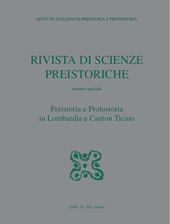Scavi ottocenteschi nelle necropoli di Golasecca-Sesto Calende-Castelletto Ticino
P. 637-650
The first excavations in the cemeteries of Golasecca area were carried out by G.B. Giani, in the years 1816-1825. His large collection has been dispersed in many museums, above all the archaeological museum of Milan and that of Saint-Germain-en-Laye, and no closed finds have been preserved. In the years between 1850 and 1880 important collections of antiquities from Golasecca were formed: the collection of G. Dalla Rosa, that of Ermes Visconti di San Vito, the Villa collection then inherited by the Borromeo family, the collections Quaglia, Garovaglio, Delfinoni, Galli, Seletti. Only in some cases the original associations of materials have been preserved. We present and discuss some interesting cases. A tomb discovered in October 1879 at Castelletto Ticino loc. Motto Fontanile, includes an urn decorated with burnished vertical bands, the bowl-lid, the narrow-necked accessory pot, two cups with inner burnished decoration, a globular pot decorated with pattern-burnished designs.
The bronze objects found inside the urn were fixed to a wooden plate but, unfortunately, they are no longer identifiable in the Museum. In June 1873 A. Bertrand and A. Maitre, with the help of P. Guazzoni, dug some burials at the Galliasco hill. Among these, tomb n. 4, a cist made from slate slabs, has an interesting assemblage dating to the G. II B phase (de Marinis 2010). Between 1876 and 1890 Carlo Marazzini was engaged in many excavations for profit, he sold finds to the archaeological museum in Turin and in part to the Civic Museum of Novara. As regards the latter, it was possible to reconstruct the most reliably assemblages (Gambari, Malnati 1980), while the publication of the tombs of the Turin museum by L. Pauli (1971) was based on an inventory drawn up in 1955, which is clearly unreliable.The protagonist of the research carried out during the second half of the nineteenth century in the cemeteries of Golasecca area was Pompeo Castelfranco.
He excavated in several locations in Castelletto Ticino, especially at Bosco del Monte (de Marinis 1998) and in Golasecca territory: Monsorino, Galliasco, Corneliane, Lazzaretto. Among the graves excavated for L. Pigorini, tombs M and RR are of a particular importance. The first one, discovered in Bosco del Monte on the September 11th, 1875, was considered by Castelfranco one of the rarest graves of transition between the first and the second Golasecca period. The grave excavated by P. Castelfranco on April 2, 1874 near Oldrini farm in the municipality of Castelletto Ticino, together with the one with a bronze situla from Lazzaretto (Golasecca) (de Marinis 1990-1991), is the most important of his discoveries. It was a cist made of slate slabs. Within there were a large ovoid urn, closed by an inverted bowl; next a smaller urn decorated with burnished pattern closed by a cup with grid-burnished designs.
The ceramic grave goods were completed by a globular pot decorated in black “stralucido”, and two cups decorated with a burnished grid motif. Inside the two urns there was a narrow-neck accessory pot. In the larger urn there were, besides the ashes, four bronze serpentine fibulae, a leech fibula and a bronze ring. In the smaller urn had been placed the ashes, eight boat-shaped and leech fibulae, partially in fragments and partly whole, two fragments of serpentine fibulae, a bronze ring, a spindle-whorl, a sheet-bronze belt plate, also an unburnt human jaw. Unfortunately, the burned bones and the unburnt jaw are no longer preserved. [Publisher's text]
-
Artikel aus derselben Ausgabe (einzeln erhältlich)
-
Informationen
DOI: 10.32097/1200
ISSN: 2282-457X


